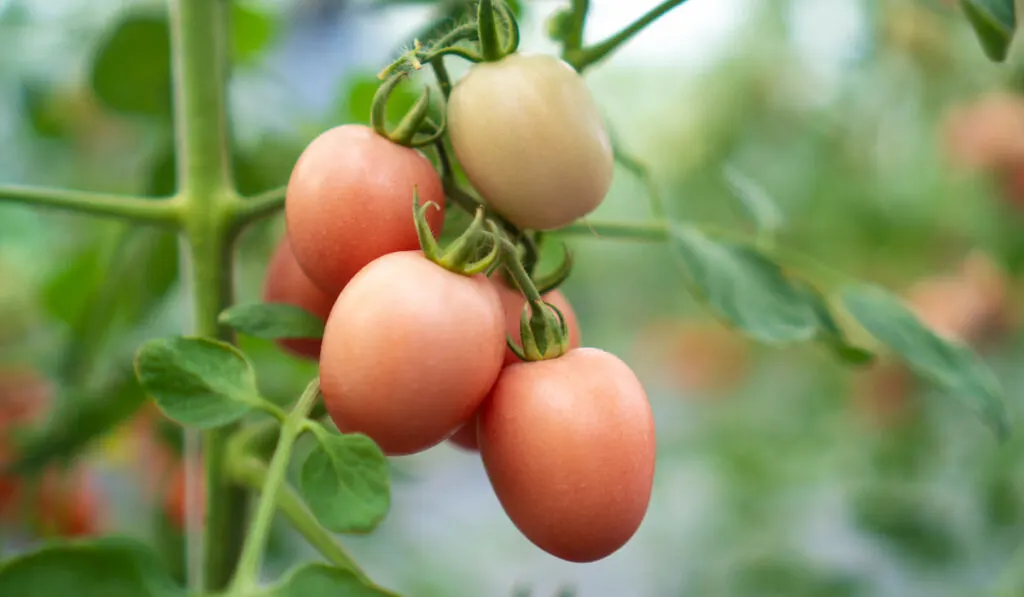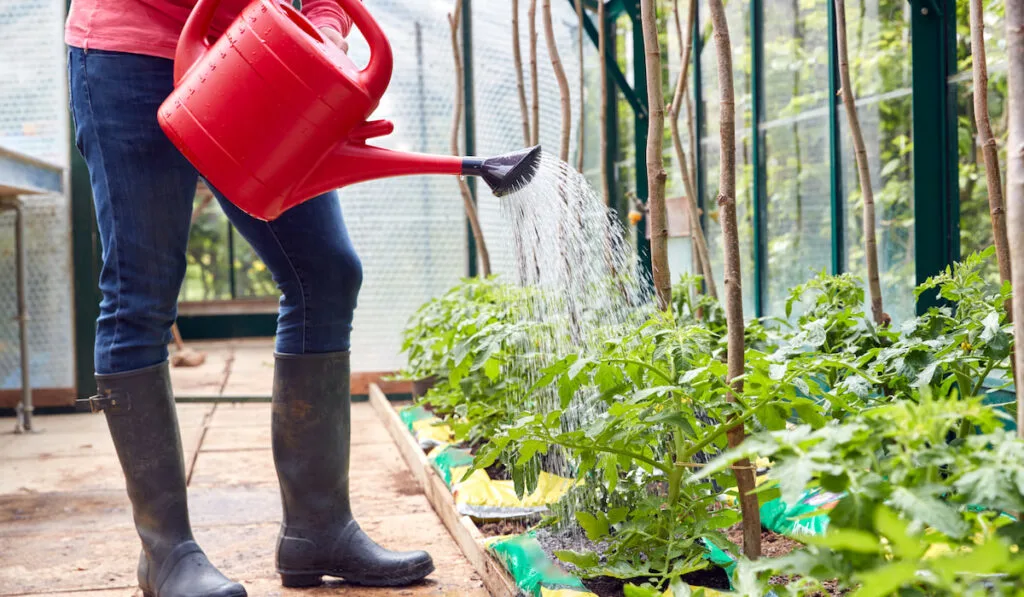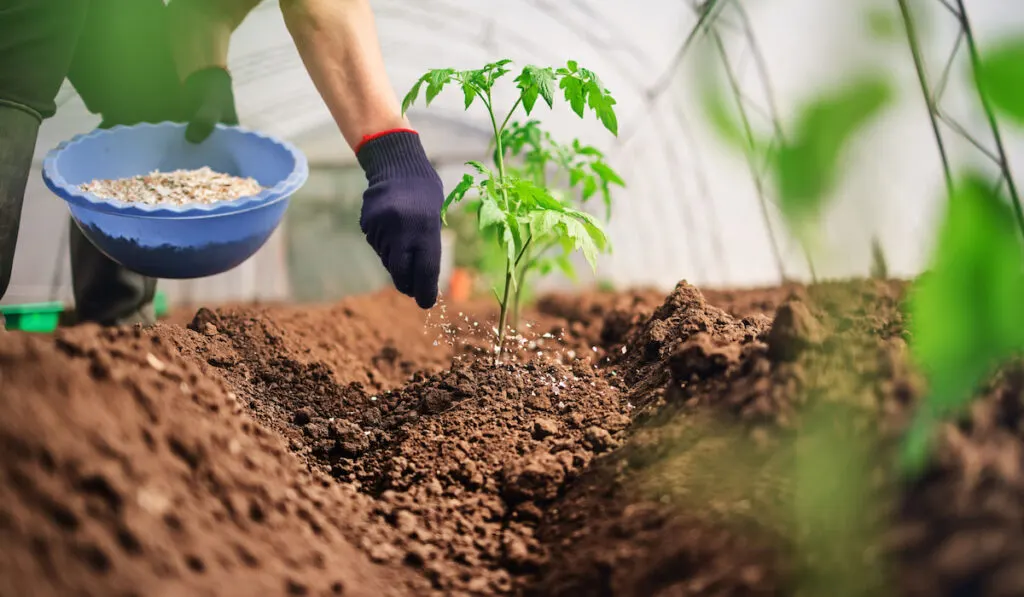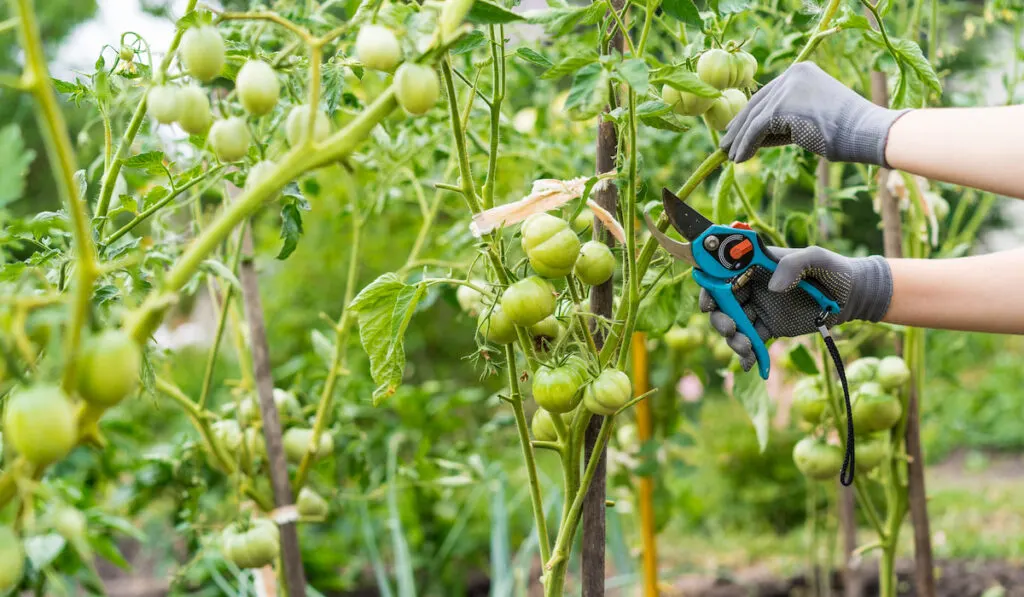Traditionally, tomatoes are summer plants. But it can be too hot for even heat-loving plants in the middle of the summer, depending on your location.
How hot is too hot for tomato plants?
The optimal daytime temperature range for tomato plants is between 70°F and 85°F (21°C–29°C). Temperatures higher than 90°F (32°C) cause heat stress.
Heat stress leads to blossom drop and affects pollination and fruit maturation, resulting in poor yield.
In the rest of this article, we examine what temperatures are too high for tomato plants and how to tell if it is too hot for your tomatoes.
We also look at how to protect your plants from the scorching summer heat; read on to learn more!

Table of Contents
Can It Be Too Hot for Tomato Plants?
Although tomatoes thrive in summer, extreme heat stresses them.
Excessive heat might hinder your plants’ capacity to bear fruit, and it can be too hot for the fruit to ripen.
Therefore, it is logical to worry about extreme heat affecting your plants.
The sensitivity of tomatoes to changes in temperature is extraordinary.
For example, tomatoes will not blossom when temperatures exceed 90°F (32°C) during the day or 75°F (24°C) at night.
Higher temperatures put the plants under extreme pressure, leading to:
- Wilting
- Blossom drops
- Sunscald
The good news is if you keep your plants watered, they won’t likely die in a heat wave.
Moreover, even in hot temperatures, tomato fruits already maturing on the vine will be unaffected.
What are the drawbacks of hot weather, then?
Hot weather creates constant heat stress. The toll that the heat takes on the plants is even more concerning.
Prolonged heat stress pushes a plant to enhance transpiration, hindering its productivity.

How Much Sun Do Tomato Plants Like?
Tomato plants thrive well and produce better fruit in total sun exposure. They require 6 to 8 hours of direct sunlight daily.
However, this depends on your location.
While tomatoes need at least 6 hours of sun each day, they need sun protection in some regions.
Tomatoes growing in the deep South and the arid Southwest need sun protection.
Tomato plants prefer a sunny site with some moderate shade during the warmest part of the day.
Plant them where they can receive morning sun and protection from the afternoon heat.
This is important if you live where summers are sweltering, and heat waves happen often. Although plants can tolerate the sun well, they won’t pollinate and produce new fruit.
Excessive heat can affect a tomato plant from flowering to harvest time.
If it’s 90°F (32°C) during the day for two or more days, pollination might not even happen, meaning fewer fruits.

How to Tell if Your Tomato Plant Is Getting Too Much Sun
There are several signs that your tomato plant is receiving excessive sunlight. They include the following:
Leaves Turning Yellow
Tomato plant leaves turn yellowish and crunchy if they get excessive direct sunlight. The leaves change so they won’t dry out and die from too much sunshine.
Wilting
If a tomato plant receives too much direct sunshine, it may wilt.
Scorching temperatures cause plants to lose water more quickly than they can take in.
And this results in wilted leaves.
Stunted Growth
Your tomato plant may be experiencing too much heat if it isn’t growing as tall as it should. Overexposure to light can stunt your plant’s growth.
Sunscald
Tomato fruit can become more vulnerable to sunscald in intense heat.
Sunscald causes the tomato plant’s fruit to brown and sag.
Sunscalds harm the fruit’s skin. As a result, ripening tomato fruits turn yellowish or orange instead of deep red.
Slow Fruit Development
Tomatoes switch to survival mode during a heat wave.
While the plant concentrates on transferring water through its system, fruit development slows.
Persistent heat stress will eventually cause plants to stop producing fruit.
Blossom Drop
Intense sunlight and extreme heat can lead to blossom drop.
As the daily temperature rises, tomato plants lose their blooms without producing fruit.
The unripe green tomatoes may fall off the vine or stop ripening. However, larger fruits left on the plant may ripen again as temperatures drop.

Tips for Keeping Tomato Plants Healthy in the Heat
We have little control over the weather.
However, you can take preventative measures to protect your tomatoes from excessive heat.
Here are some tips for keeping your tomato plants healthy in the heat.
Water Your Plants Regularly
During a heat wave, watering your plants is a must. Tomato plants require regular irrigation, especially in the summer.
Once or twice a week, give the plants a thorough, deep watering, ensuring the soil is moist but not soggy.
Consider watering in the early morning or late afternoon to minimize water loss through evaporation.
You may need to water twice daily if there is a prolonged period of scorching weather.
When temperatures soar, a plant’s transpiration rate increases.
Thus, they should receive far more than their fair share because they strive to survive. Regular daily watering is also necessary if your soil is sandy or drains quickly.
Probe the soil using your finger. If it’s dry more than an inch deep, it’s time for watering.
To prevent water logging, increase watering frequency without increasing the amount of water.
Mulch Your Garden

Using mulch protects plants from excessive heat. After watering, mulch can act as a cooling layer for the plants.
Mulching around the tomato plant’s base can help the soil retain moisture and keep the roots cool.
Add a layer of mulch to regulate the soil’s temperature and lessen the impacts of excessive heat.
You may use organic mulch such as:
- Chopped leaves
- Straw
- Saw dust
- Wood shavings or chips
Provide Shade

Create shade for your tomato plants if your yard receives excessive sunlight. Even a little shade can help the plant survive and thrive.
The secret is to shade the plants during the hottest hours of the day if they are in full sun. Leave them exposed to the sun in the early morning and late afternoon.
You can use materials like these:
- Shade cloth
- Umbrellas
- Any other sort of temporary shade cover
Shade cloth is the most common.
Run a cord or rope a couple feet above your plants and just drape the cloth over your plants like a teepee. Do this during the hottest part of the day.
Resist the Urge to Fertilize

Many gardeners’ first response is to fertilize when they see their plants struggling.
While tomato plants need proper nourishment for optimal fruit production, fertilizer will inflict more harm than good in a heat wave.
Fertilizer stimulates new growth, which requires a lot of energy.
Under heat stress, your plant goes into survival mode and stops producing fruit.
Fertilizers will only encourage the plant to develop more leaves, which is unnecessary for a stressed plant.
Wait till the temperatures have dropped before fertilizing your plants. Also, apply the fertilizer as per the manufacturer’s directions.
To avoid excessive growth and attraction of pests, avoid overfertilizing.
Prune the Plants

Pruning your tomato plants will help improve airflow and reduce heat stress.
Don’t remove mature, healthy leaves.
Remove any yellow or damaged leaves and any suckers, which are new shoots that emerge from the main stem.
The best sun protection is a good thicket of mature leaves.
Monitor for Pests and Diseases
Healthy plants can fight off many diseases and pests on their own. Heat can foster an ideal environment for disease and pest infestation.
As a result, a tomato plant may lose its resistance against pests and disease. These issues can wreak havoc on your tomato garden if not addressed.
Signs of disease and pest infestation include:
- Leaf spots
- Wilting
- Discoloration
Keep an eye out for any symptoms of pests or disease. Control any visible infestations.
Final Thoughts
Tomato plants need a lot of sunlight to produce the best fruit. However, prolonged exposure to the sun can be harmful, especially in scorching weather.
If you grow tomatoes in a hot climate, provide shade during the afternoon to avoid sunscald. Irrigation and pruning will also minimize the effect of heat waves.
Moreover, consider selecting suitable plant varieties in a hot and dry region. These tips will help protect your plants, increase yield, and enjoy tomato farming in hot weather!
Resources
I wrote this article from my experience growing tomatoes and the following sources:
- https://www.agmrc.org/commodities-products/vegetables/tomatoes
- https://www.nidirect.gov.uk/articles/saving-water-garden
- https://foodrevolution.org/blog/how-to-grow-tomatoes/
- https://nwdistrict.ifas.ufl.edu/hort/2021/04/22/tomato-pruning-tips/
- https://www.cimmyt.org/news/pests-and-diseases-and-climate-change-is-there-a-connection/
- https://www.latimes.com/home/la-hm-heatproof-your-tomatoes-20180725-story.html
- http://ipm.illinois.edu/diseases/series900/rpd939/rpd939.html
- https://www.purdue.edu/hla/sites/yardandgarden/tomatoes-not-ripening/
- https://www.scirp.org/html/3-2600836_34554.htm
- https://hortnews.extension.iastate.edu/faq/my-tomato-plants-are-flowering-aren%E2%80%99t-setting-fruit-why
